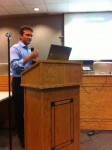Wildlife Experts Help New Castle Residents Understand Coyote Explosion

With coyotes providing the Town of New Castle with an ongoing challenge, residents are taking steps to understand the animals and their presence.
On Wednesday evening, dozens of residents packed Town Hall for a presentation called “Wild Suburbia,” a program sponsored by the newly formed Coyote Awareness and Safety Advisory Committee featuring three experts.
Dr. Chris Nagy, who runs the Wild Suburbia project with the Mianus River Gorge, explained that coyotes have called New York home since the 1920s due to the ideal conditions of fairly new forest growth. The animals are a fairly common sight in towns and even cities across the country.
“Coyotes, going from the prairie out west, have colonized all of North America except for the high arctic and Long Island,” Nagy said.
With the exception of roads, the suburbs provide the perfect habitat for coyotes because of forest land, a low number of predators and food and water sources that are unintentionally provided by humans, he said.
Although most people are afraid of coyotes, they will generally ignore humans as long as they don’t feel threatened. Statistically, humans are more likely to be harmed by a dog, Nagy said. Each year, an average of 4.5 million dog bites are reported in the United States and 34 people are killed in dog attacks, compared to 142 total coyote attacks in the past 45 years and only two reported deaths.
Although coyotes aren’t naturally fearful of humans, experts noted that it is harmful to allow them to become too comfortable. Coyotes are adaptive animals and can easily acclimate to their environment. Therefore, they will continually return to areas where they receive positive reinforcement.
Reinforcement, while usually unintentional, can come in the form of food or even dog toys that are left in a yard, which attracts the naturally curious coyote. Experts advise against feeding pets outside or leaving animals and children outside unattended. Keeping a lid on all garbage cans and using bird feeders that prevent seeds from dropping to the ground are also recommended.
Mary Paglieri, a behavioral ecologist and human-animal conflict consultant from California who participated in the event via phone, explained that coyotes will not actively seek out compost or small animals as a source of food, but are opportunistic and will utilize those food sources that are presented to them, especially if their natural food supply has dwindled. She noted that coyotes will respond to the changes that humans cause, but stressed that residents follow the guidelines to keep the animals at bay.
“Something like this needs community cooperation,” Paglieri said. “If you remove the source that may be attracting the coyotes…the population will disperse, they’ll look for greener pastures elsewhere. But one needs to be patient and it needs to be coordinated on a community level.”
If a coyote is repeatedly seen on a property, Paglieri recommended using novel stimuli to deter the animal. It could be a large object, a sprinkler or light with a motion sensor. Although effective, residents must move the object every five to seven days so that the coyote doesn’t adapt and find a way around it.
The experts also recommend hazing–making loud noises to scare the animal. When hiking, it is recommended to stick to established trails to avoid encountering a den. Nagy noted that residents ought to be mindful in the summer when coyotes have pups. If a person encounters a coyote in the wild that will not back down or move from its position between April and June, it is likely protecting cubs and the person should leave the area, he said.
Trapping or killing coyotes is a largely ineffective method of controlling the coyote population, which has grown over the years because of the elimination of wolves that provided competition in the wild. Dr. Jonathan Way, a coywolf/eastern coyote researcher from Massachusetts, explained via phone that trapping is an “eye-for-an-eye approach” and doesn’t guarantee a specific coyote being caught that may be posing problems.
In addition, it is easy for other animals, including pets, to get caught in the traps. Setting traps will also not deter coyotes because they are incapable of associating them with humans, Paglieri said.
Although there is a coyote hunting season in Westchester, Nagy explained that killing them can cause a population increase due to decreased competition which results in more mating. In addition, given New Castle’s dense population, hunting would be nearly impossible.
“There is a season in New York for coyotes, and people are welcome to take advantage of it…but it’s going to be tough to hunt in the middle of town,” Nagy said.

Examiner Media – Keeping you informed with professionally-reported local news, features, and sports coverage.
